Impacts of Pollutant Emissions from Typical Petrochemical Enterprises on Air Quality in the North China Plain
Abstract
1. Introduction
2. Materials and Methods
2.1. Study Domain
2.2. Preprocessing of Field Measurement Data
2.2.1. Acquisition and Processing of Industrial Pollutant Emission Data
2.2.2. Normalization of Data
2.3. Model Description
2.3.1. Atmospheric Chemical Transport Model
2.3.2. Model Inputs and Evaluation
3. Results
3.1. Emissions of Atmospheric Pollutants from Typical Petrochemical Enterprises
3.2. Model Evaluation and Spatial-Temporal Distribution of Air Pollutant Concentrations
3.2.1. Evaluation of Model Performance
3.2.2. Spatial-Temporal Distribution of Air Pollutant Concentrations
3.3. Emission Contribution from Typical Petrochemical Enterprises to Regional Air Quality
3.3.1. Spatial-Temporal Distribution in the Contributions
3.3.2. Quantitative Contributions Based on the Distance from the Sources
3.3.3. Quantitative Contributions to the Air Quality over the NCP Region
4. Discussion
5. Conclusions
Author Contributions
Funding
Institutional Review Board Statement
Informed Consent Statement
Data Availability Statement
Acknowledgments
Conflicts of Interest
References
- Zhang, G.X.; Jia, Y.Q.; Su, B.; Xiu, J. Environmental regulation, economic development and air pollution in the cities of China: Spatial econometric analysis based on policy scoring and satellite data. J. Clean. Prod. 2021, 328, 129496. [Google Scholar] [CrossRef]
- Zhu, J.; Chen, L.; Hong, L. Multi-pollutant air pollution and associated health risks in China from 2014 to 2020. Atmos. Environ. 2022, 268, 118829. [Google Scholar] [CrossRef]
- Ministry of Ecology and Environment of the People’s Republic of China. Bulletin on the State of China’s Ecology and Environment of Year 2020; Ministry of Ecology and Environment of the People’s Republic of China: Beijing, China, 2021; Available online: https://www.mee.gov.cn/hjzl/sthjzk/zghjzkgb/ (accessed on 26 August 2020).
- Jazcilevich, A.D.; Garcia, A.R.; Ruiz-Suarez, L.G. A modeling study of air pollution modulation through land-use change in the valley of Mexico. Atmos. Environ. 2002, 36, 2297–2307. [Google Scholar] [CrossRef]
- Xian, C.F.; Zhang, X.L.; Zhang, J.J.; Fan, Y.P.; Zheng, H.; Salzman, J.; Ouyang, Z.Y. Recent patterns of anthropogenic reactive nitrogen emissions with urbanization in China: Dynamics, major problems, and potential solutions. Sci. Total Environ. 2019, 656, 1071–1081. [Google Scholar] [CrossRef]
- Adebiyi, F.M. Air quality and management in petroleum refining industry: A review. Environ. Chem. Ecotoxicol. 2022, 4, 89–96. [Google Scholar] [CrossRef]
- Zhao, F.; Fan, Y.; Zhang, S.H. Assessment of efficiency improvement and emission mitigation potentials in China’s petroleum refining industry. J. Clean. Prod. 2021, 280, 124482. [Google Scholar] [CrossRef]
- Han, D.M.; Gao, S.; Fu, Q.Y.; Cheng, J.P.; Chen, X.J.; Xu, H.; Liang, S.; Zhou, Y.; Ma, Y.N. Do volatile organic compounds (VOCs) emitted from petrochemical industries affect regional PM2.5? Atmos. Res. 2018, 209, 123–130. [Google Scholar] [CrossRef]
- Luo, Y.Y.; Zhou, X.H.; Zhang, Z.J.; Xiao, Y.; Wang, Z.; Zhou, Y.; Wang, W.X. PM2.5 pollution in a petrochemical industry city of northern China: Seasonal variation and source apportionment—ScienceDirect. Atmos. Res. 2018, 212, 285–295. [Google Scholar] [CrossRef]
- Dai, J.P.; Zhu, C.; Guo, W.J.; Wang, L.; Zhang, H. Characteristics and source apportionment of polycyclic aromatic hydrocarbons in indoor PM2.5 in a petroleum and chemical industrial area. Environ. Monit. China 2017, 33, 56–64. [Google Scholar] [CrossRef]
- Chen, L.; Li, K.; Chen, S.Y.; Wang, X.F.; Tang, L.W. Industrial activity, energy structure, and environmental pollution in China. Energy Econ. 2021, 104, 105633. [Google Scholar] [CrossRef]
- Zhang, T.; Lin, Q.; Xue, Z.; Munson, R.; Magneschi, G. Sinopec Zhongyuan Oil Field Company Refinery CCS-EOR Project. Energy Procedia 2017, 114, 5869–5873. [Google Scholar] [CrossRef]
- Adams, D.; Oh, D.H.; Kim, D.W.; Lee, C.H.; Oh, M. Prediction of SOx–NOx emission from a coal-fired CFB power plant with machine learning: Plant data learned by deep neural network and least square support vector machine. J. Clean. Prod. 2020, 270, 122310. [Google Scholar] [CrossRef]
- Lin, H.; Feng, X.; Fu, T.-M.; Tian, H.; Ma, Y.; Zhang, L.; Jacob, D.J.; Yantosca, R.M.; Sulprizio, M.P.; Lundgren, E.W.; et al. WRF-GC (v1.0): Online coupling of WRF (v3.9.1.1) and GEOS-Chem (v12.2.1) for regional atmospheric chemistry modeling—Part 1: Description of the one-way model. Geosci. Model Dev. 2020, 13, 3241–3265. [Google Scholar] [CrossRef]
- Feng, X.; Lin, H.; Fu, T.-M.; Sulprizio, M.P.; Zhuang, J.; Jacob, D.J.; Tian, H.; Ma, Y.; Zhang, L.; Wang, X.; et al. WRF-GC (v2.0): Online two-way coupling of WRF (v3.9.1.1) and GEOS-Chem (v12.7.2) for modeling regional atmospheric chemistry–meteorology interactions. Geosci. Model Dev. 2021, 14, 3741–3768. [Google Scholar] [CrossRef]
- Bey, I.; Jacob, D.J.; Yantosca, R.M.; Logan, J.A.; Logan, B.; Field, A.M.; Fiore, Q.; Li, H.; Liu, L.; Mickley, J.; et al. Global modeling of tropospheric chemistry with assimilated meteorology: Model description and evaluation. J. Geophys. Res. 2001, 106, 23073–23096. [Google Scholar] [CrossRef]
- Park, R.J.; Jacob, D.J.; Field, B.D.; Yantosca, R.M.; Chin, M. Natural and transboundary pollution influences on sulfate-nitrate-ammonium aerosols in the United States: Implications for policy. J. Geophys. Res. 2004, 109, D15204. [Google Scholar] [CrossRef]
- Pye HO, T.; Chan AW, H.; Barkley, M.P.; Seinfeld, J.H. Global modeling of organic aerosol: The importance of reactive nitrogen (NOx and NO3). Atmos. Chem. Phys. 2010, 10, 11261–11276. [Google Scholar] [CrossRef]
- Sherwen, T.; Schmidt, J.A.; Evans, M.J.; Carpenter, L.J.; Großmann, K.; Eastham, S.D.; Jacob, D.J.; Dix, B.; Koenig, T.K.; Sinreich, R.; et al. Global impacts of tropospheric halogens (Cl, Br, I) on oxidants and composition in GEOS-Chem. Atmos. Chem. Phys. 2016, 16, 12239–12271. [Google Scholar] [CrossRef]
- Shikhovtsev, A.Y.; Kovadlo, P.G.; Lezhenin, A.A.; Korobov, O.A.; Kiselev, A.V.; Russkikh, I.V.; Kolobov, D.Y.; Shikhovtsev, M.Y. Influence of Atmospheric Flow Structure on Optical Turbulence Characteristics. Appl. Sci. 2023, 13, 1282. [Google Scholar] [CrossRef]
- Bernardino, D.A.; Mazzarella, V.; Pecci, M.; Casasanta, G.; Cacciani, M.; Ferretti, R. Interaction of the Sea Breeze with the Urban Area of Rome: WRF Meso-scale and WRF Large-Eddy Simulations Compared to Ground-Based Observations. Bound.-Layer Meteorol. 2022, 185, 333–363. [Google Scholar] [CrossRef]
- Lysenko, S.A.; Zaiko, P.O. Estimates of the Earth surface influence on the accuracy of numerical prediction of air temperature in Belarus using the WRF model. Hydrometeorol. Res. Forecast. 2021, 382, 50–68. [Google Scholar] [CrossRef]
- Morrison, H.; Thompson, G.; Tatarskii, V. Impact of Cloud Microphysics on the Development of Trailing Stratiform Precipitation in a Simulated Squall Line: Comparison of One- and Two-Moment Schemes. Mon. Weather Rev. 2009, 137, 991–1007. [Google Scholar] [CrossRef]
- Iacono, M.J.; Delamere, J.S.; Mlawer, E.J.; Shephard, M.W.; Clough, S.A.; Collins, W.D. Radiative forcing by long-lived greenhouse gases: Calculations with the AER radiative transfer models. J. Geophys. Res.-Atmos. 2008, 113, D13103. [Google Scholar] [CrossRef]
- Jimenez, P.A.; Dudhia, J.; Gonzalez-Rouco, J.F.; Navarro, J.; Montavez, J.P.; Garcia-Bustamante, E. A Revised Scheme for the WRF Surface Layer Formulation. Mon. Weather Rev. 2012, 140, 898–918. [Google Scholar] [CrossRef]
- Chen, F.; Dudhia, J. Coupling an advanced land surface-hydrology model with the Penn State-NCAR MM5 modeling system. Part I: Model implementation and sensitivity. Mon. Weather Rev. 2001, 129, 569–585. [Google Scholar] [CrossRef]
- Chen, F.; Dudhia, J. Coupling an advanced land surface-hydrology model with the Penn State-NCAR MM5 modeling system. Part II: Preliminary model validation. Mon. Weather Rev. 2001, 129, 587–604. [Google Scholar] [CrossRef]
- Nakanishi, M.; Niino, H. An improved mellor-yamada level-3 model: Its numerical stability and application to a regional prediction of advection fog. Bound.-Lay. Meteorol. 2006, 119, 397–407. [Google Scholar] [CrossRef]
- Tiedtke, M. A comprehensive mass flux scheme for cumulus parameterization in large-scale models. Mon. Weather. Rev. 1989, 117, 1779–1800. [Google Scholar] [CrossRef]
- Li, X.; Zhang, Q.; Zheng, B.; Wang, K.; Chen, Y.; Wallington, T.J.; Han, W.J.; Shen, W.; Zhang, X.Y.; He, K. Source contributions of urban PM2.5 in the Beijing–Tianjin–Hebei region: Changes between 2006 and 2013 and relative impacts of emissions and meteorology. Atmos. Environ. 2015, 123, 229–239. [Google Scholar] [CrossRef]
- Wu, F.; Yu, Y.; Sun, J.; Zhang, J.; Wang, J.; Tang, G.; Wang, Y. Characteristics, source apportionment and reactivity of ambient volatile organic compounds at Dinghu Mountain in Guangdong Province, China. Sci. Total Environ. 2016, 548–549, 347–359. [Google Scholar] [CrossRef]
- Wei, W.; Lv, Z.F.; Li, Y.; Wang, L.T.; Cheng, S.Y.; Liu, H. A WRF-Chem model study of the impact of VOCs emmision of a huge petrochemical industrial zone on the summertime ozone in Beijing, China. Atmos. Environ. 2018, 175, 44–53. [Google Scholar] [CrossRef]
- Fu, S.; Guo, M.X.; Luo, J.M.; Han, D.M.; Chen, X.J.; Jia, H.H.; Jin, X.D.; Liao, H.X.; Wang, X.; Fan, L.P.; et al. Improving VOCs control strategies based on source characteristics and chemical reactivity in a typical coastal city of South China through measurement and emission inventory. Sci. Total Environ. 2020, 744, 140825. [Google Scholar] [CrossRef] [PubMed]
- Ministry of Ecology and Environment of the People’s Republic of China. Second National Survey of Pollution Sources; Ministry of Ecology and Environment of the People’s Republic of China: Beijing, China, 2020; Available online: http://www.mee.gov.cn/ (accessed on 3 October 2021).
- Wei, W.; Cheng, S.; Li, G.; Wang, H. Characteristics of ozone and ozone precursors (VOCs and NOx) around a petroleum refinery in Beijing, China. J. Environ. Sci. 2014, 26, 332–342. [Google Scholar] [CrossRef] [PubMed]
- Li, M.L.; Mao, J.Y.; Chen, S.Q.; Bian, J.C.; Bai, Z.X.; Wang, X.M.; Chen, W.H.; Yu, P.F. Significant contribution of lightning NOx to summertime surface O3 on the Tibetan Plateau. Sci. Total Environ. 2022, 829, 154639. [Google Scholar] [CrossRef] [PubMed]
- Huang, B.; Liu, M.; Ren, Z.; Bi, X.; Zhang, G.; Sheng, G.; Fu, J. Chemical composition, diurnal variation and sources of PM2.5 at two industrial sites of South China. Atmos. Pollut. Res. 2013, 4, 298–305. [Google Scholar] [CrossRef]
- Wang, Y.; Jia, C.; Tao, J.; Zhang, L.; Liang, X.; Ma, J.; Gao, H.; Huang, T.; Zhang, K. Chemical characterization and source apportionment of PM2.5 in a semi-arid and petrochemical-industrialized city, Northwest China. Sci. Total Environ. 2016, 573, 1031–1040. [Google Scholar] [CrossRef] [PubMed]
- Zhang, Y.; Cai, J.; Wang, S.; He, K.; Zheng, M. Review of receptor-based source apportionment research of fine particulate matter and its challenges in China. Sci. Total Environ. 2017, 586, 917–929. [Google Scholar] [CrossRef]
- Chen, X.; Yang, T.; Wang, Z.F.; Hao, Y.F.; He, L.T.; Sun, H.H. Investigating the impacts of coal-fired power plants on ambient PM2.5 by a combination of a chemical transport model and receptor model. Sci. Total Environ. 2020, 727, 138407. [Google Scholar] [CrossRef] [PubMed]
- Wang, W.J. Transport Characteristic of Pollutants Emitted fromCoal-fired Power Plants in Fenwei Plain Area Using WRF and CALPUFF Model. Master’s Thesis, Chang’an University, Xi’an, China, 2020. (In Chinese). [Google Scholar]
- Jin, C.Y.; Wu, A.B. The nonlinear impact of industrial economic structure and economic growth on environmental pollution. Chin. J. Popul. Resour. Environ. 2017, 27, 64–73. (In Chinese) [Google Scholar]
- Yang, M.; Yan, X.H.; Li, Q.Y. Impact of environmental regulations on the efficient control of industrial pollution in China. Chin. J. Popul. Resour. Environ. 2021, 19, 230–236. [Google Scholar] [CrossRef]
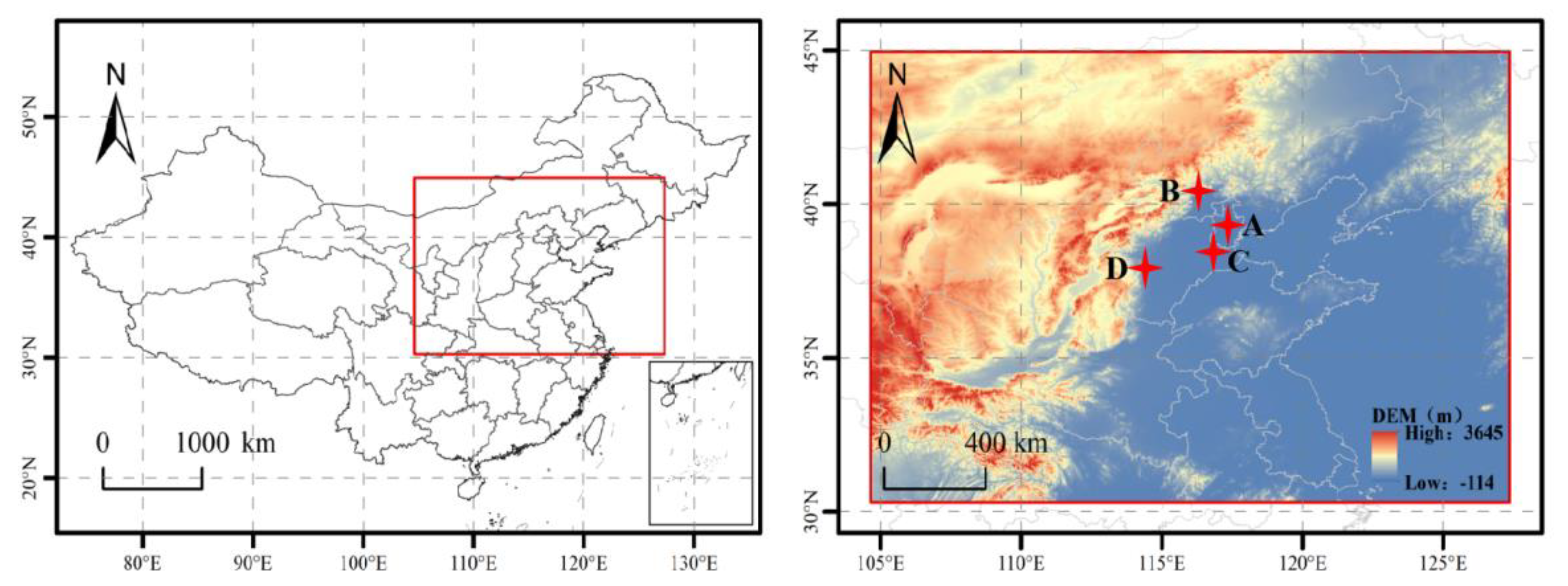

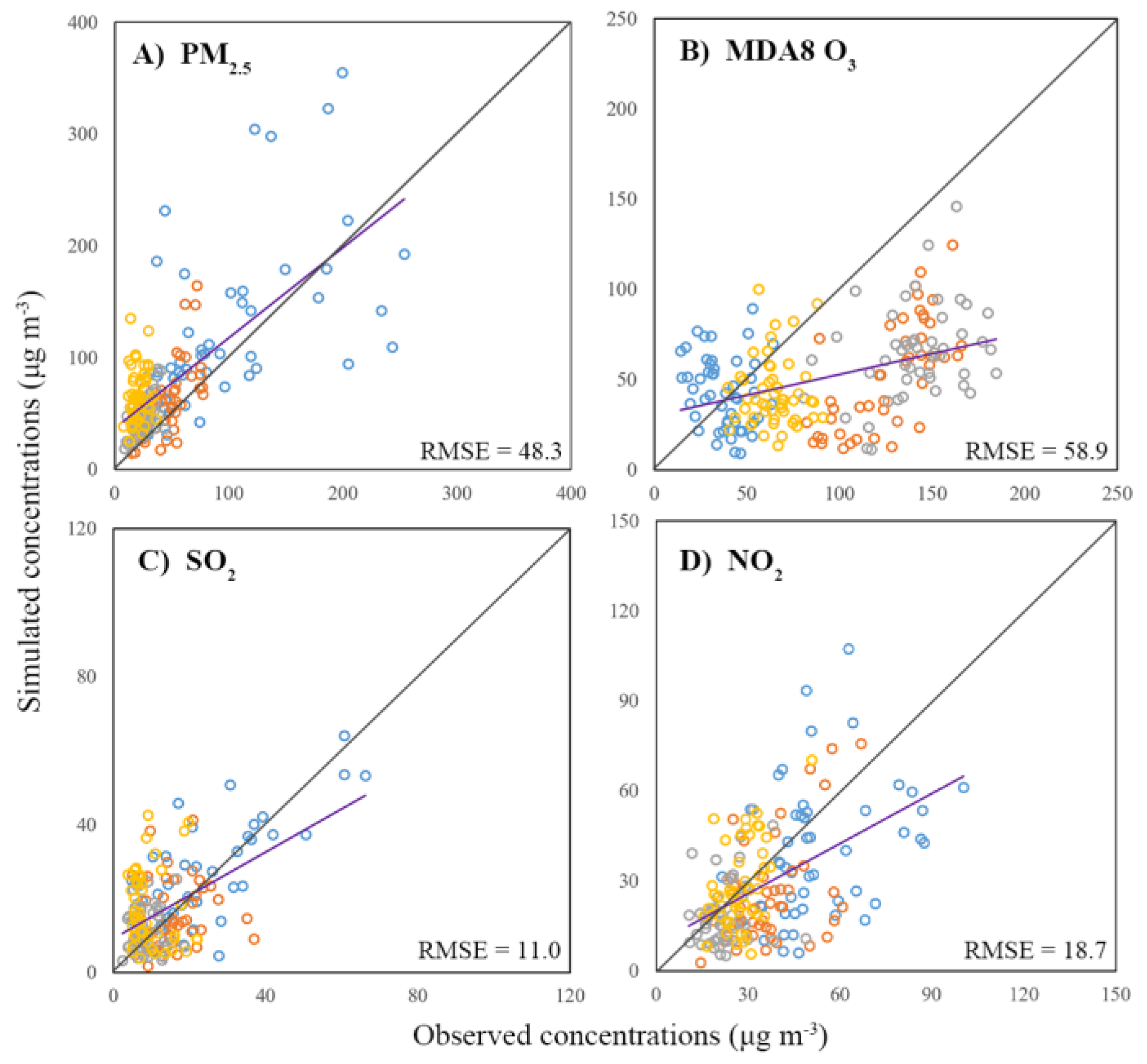
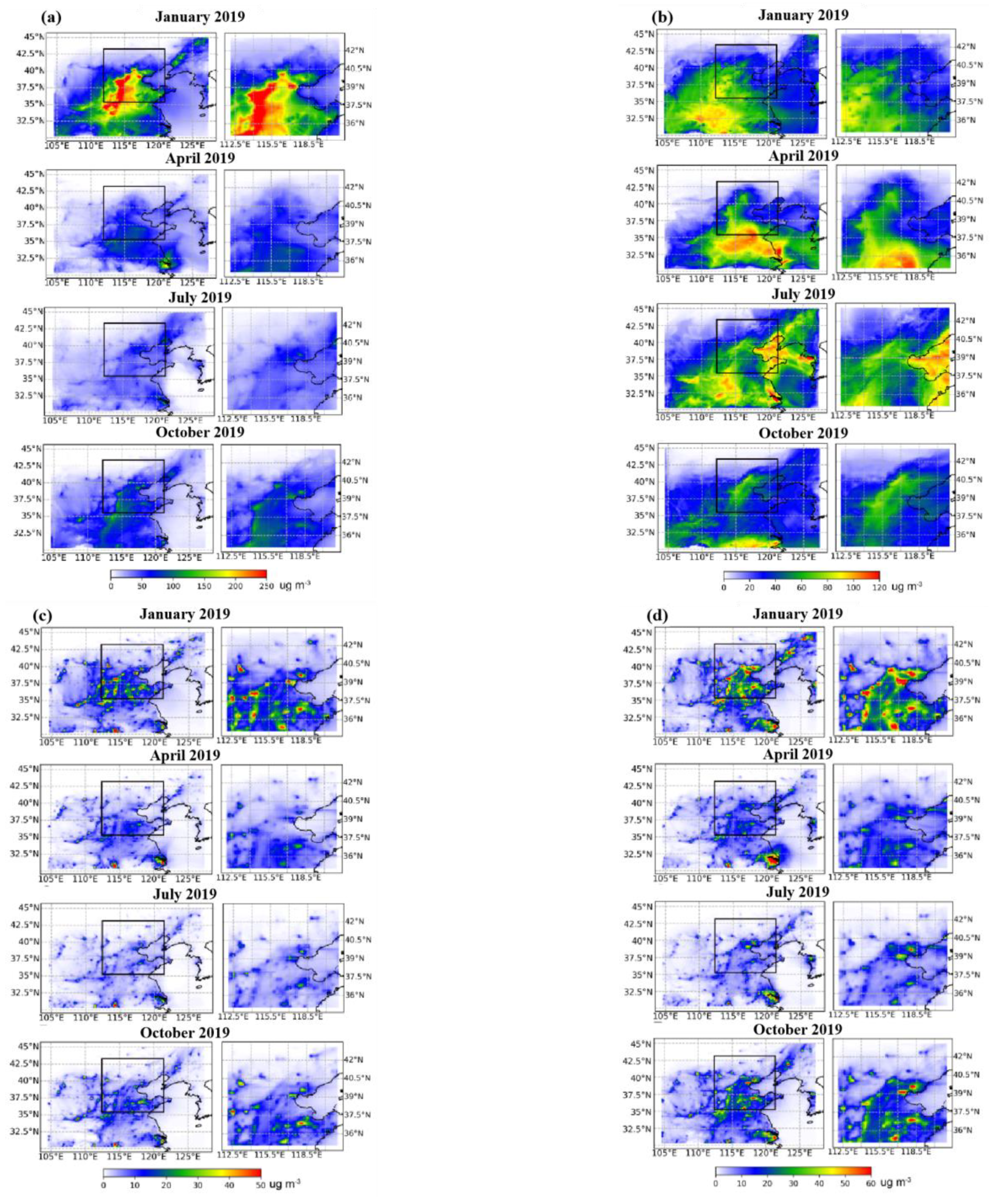
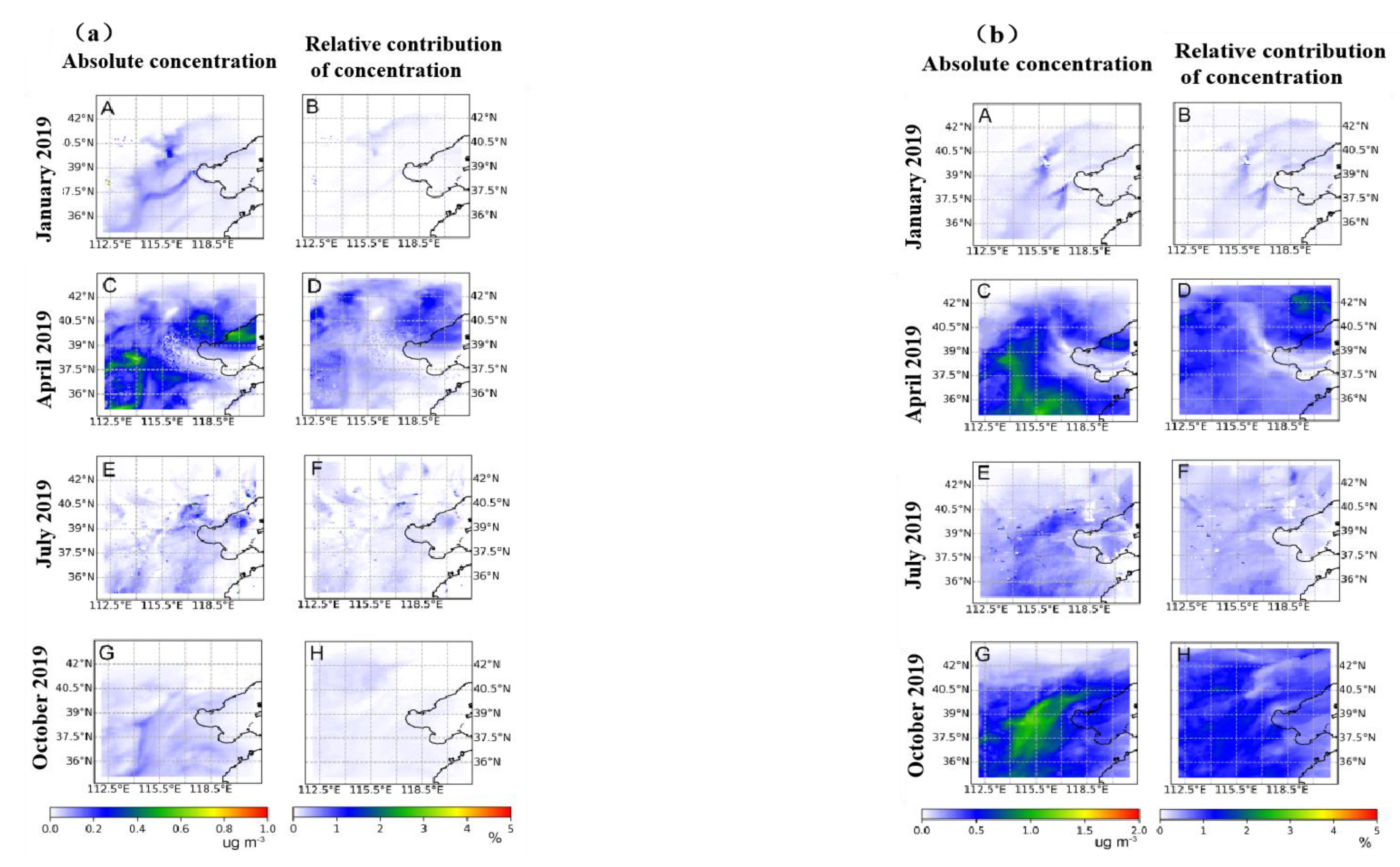
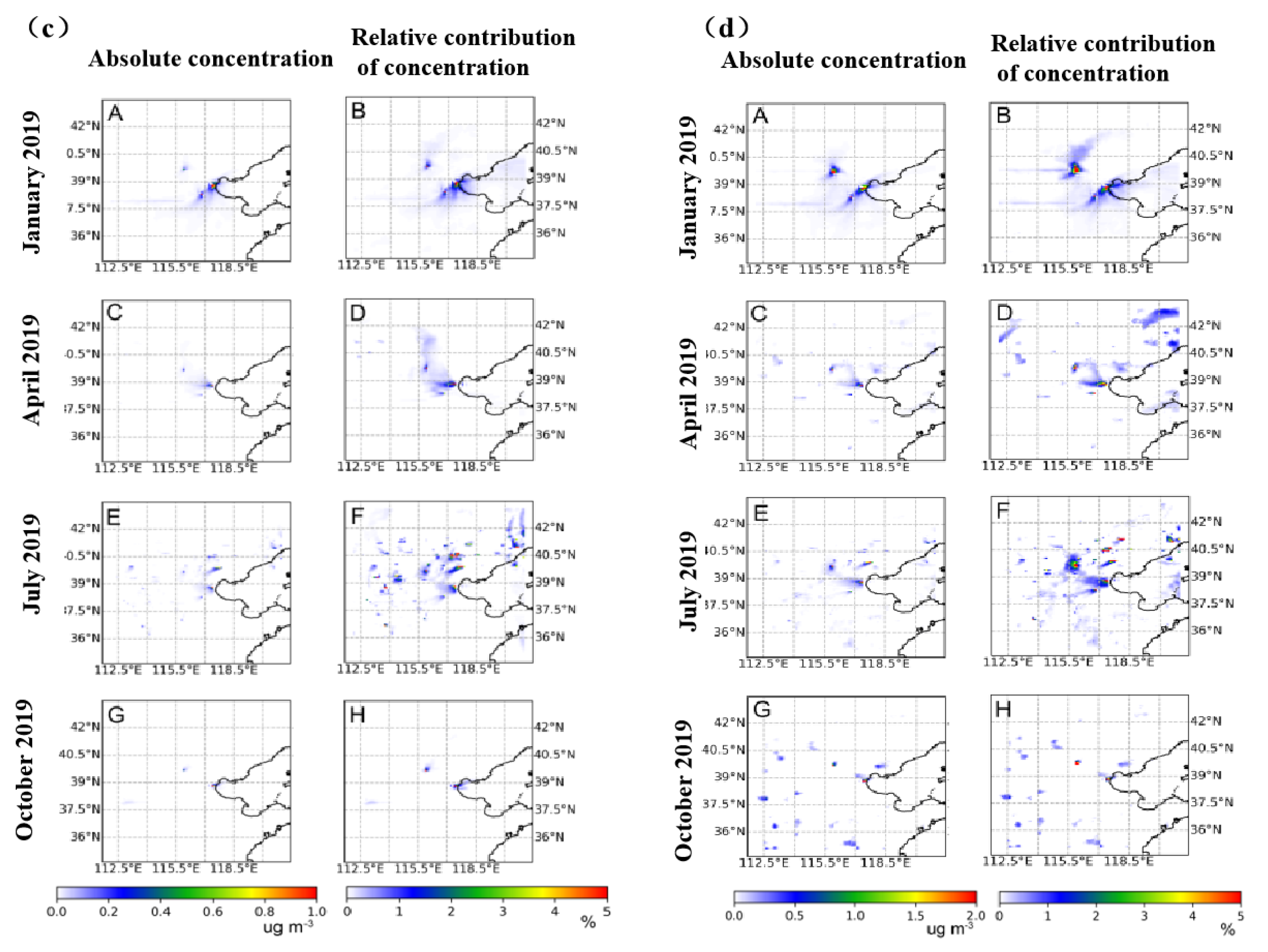
| Enterprises | Annual SO2 Emission (t/a) | Annual NOx Emission (t/a) | Annual VOCs Emission (t/a) |
|---|---|---|---|
| A | 235.5 | 1146.1 | 2104.3 |
| B | 59.4 | 1003.6 | 1968.0 |
| C | 42.9 | 125.9 | 435.8 |
| D | 77.6 | 216.0 | 763.0 |
| Total | 415.3 | 2491.7 | 5271.2 |
| <9 km | <27 km | <81 km | <243 km | |||
|---|---|---|---|---|---|---|
| Enterprise A | PM2.5 | Jan. | 0.06 | 0.05 | 0.05 | 0.04 |
| Apr. | 0.30 | 0.28 | 0.28 | 0.32 | ||
| Jul. | 0.13 | 0.12 | 0.12 | 0.12 | ||
| Oct. | 0.04 | 0.05 | 0.06 | 0.07 | ||
| SO2 | Jan. | 2.76 | 1.17 | 0.61 | 0.28 | |
| Apr. | 1.37 | 0.80 | 0.43 | 0.17 | ||
| Jul. | 1.03 | 0.48 | 0.26 | 0.19 | ||
| Oct. | 1.80 | 0.51 | 0.18 | 0.06 | ||
| NO2 | Jan. | 2.79 | 1.22 | 0.62 | 0.32 | |
| Apr. | 2.78 | 1.28 | 0.59 | 0.26 | ||
| Jul. | 2.24 | 1.00 | 0.53 | 0.31 | ||
| Oct. | 2.93 | 0.90 | 0.31 | 0.14 | ||
| Enterprise B | PM2.5 | Jan. | 0.18 | 0.10 | 0.07 | 0.05 |
| Apr. | 0.27 | 0.27 | 0.30 | 0.34 | ||
| Jul. | 0.03 | 0.04 | 0.07 | 0.12 | ||
| Oct. | 0.06 | 0.05 | 0.05 | 0.06 | ||
| SO2 | Jan. | 0.94 | 0.35 | 0.13 | 0.19 | |
| Apr. | 0.70 | 0.34 | 0.16 | 0.19 | ||
| Jul. | 0.64 | 0.42 | 0.20 | 0.26 | ||
| Oct. | 1.01 | 0.31 | 0.08 | 0.07 | ||
| NO2 | Jan. | 4.65 | 1.65 | 0.62 | 0.36 | |
| Apr. | 2.17 | 0.87 | 0.32 | 0.30 | ||
| Jul. | 1.64 | 1.04 | 0.50 | 0.45 | ||
| Oct. | 2.88 | 0.78 | 0.22 | 0.17 | ||
| Enterprise C | PM2.5 | Jan. | 0.09 | 0.07 | 0.05 | 0.04 |
| Apr. | 0.09 | 0.11 | 0.18 | 0.25 | ||
| Jul. | 0.13 | 0.11 | 0.12 | 0.11 | ||
| Oct. | 0.07 | 0.07 | 0.07 | 0.07 | ||
| SO2 | Jan. | 1.05 | 0.75 | 0.80 | 0.26 | |
| Apr. | 0.43 | 0.36 | 0.53 | 0.14 | ||
| Jul. | 0.47 | 0.41 | 0.37 | 0.12 | ||
| Oct. | 0.00 | 0.00 | 0.21 | 0.05 | ||
| NO2 | Jan. | 1.13 | 0.88 | 0.85 | 0.32 | |
| Apr. | 0.49 | 0.30 | 0.72 | 0.21 | ||
| Jul. | 1.32 | 0.97 | 0.90 | 0.29 | ||
| Oct. | 0.00 | 0.00 | 0.36 | 0.10 | ||
| Enterprise D | PM2.5 | Jan. | 0.03 | 0.03 | 0.03 | 0.04 |
| Apr. | 0.39 | 0.41 | 0.43 | 0.42 | ||
| Jul. | 0.09 | 0.07 | 0.08 | 0.08 | ||
| Oct. | 0.10 | 0.10 | 0.10 | 0.08 | ||
| SO2 | Jan. | 0.05 | 0.04 | 0.03 | 0.03 | |
| Apr. | 0.01 | 0.00 | 0.00 | 0.01 | ||
| Jul. | 0.02 | 0.01 | 0.02 | 0.03 | ||
| Oct. | 0.00 | 0.00 | 0.00 | 0.00 | ||
| NO2 | Jan. | 0.07 | 0.05 | 0.03 | 0.04 | |
| Apr. | 0.05 | 0.05 | 0.04 | 0.02 | ||
| Jul. | 0.20 | 0.12 | 0.11 | 0.10 | ||
| Oct. | 0.00 | 0.00 | 0.04 | 0.02 |
| Pollutants | Month | Total Atmospheric Concentrations (μg m−3) | Concentrations Driven by Petrochemical Enterprises (×10−3 μg m−3) s | Contribution Ratio (%) |
|---|---|---|---|---|
| PM2.5 | Jan. | 129.1 | 57.7 | 0.05 |
| Apr. | 46.1 | 193.1 | 0.42 | |
| Jul. | 34.1 | 33.6 | 0.10 | |
| Oct. | 55.0 | 39.0 | 0.07 | |
| SO2 | Jan. | 10.1 | 11.4 | 0.11 |
| Apr. | 4.5 | 2.9 | 0.06 | |
| Jul. | 3.5 | 4.7 | 0.14 | |
| Oct. | 5.7 | 1.4 | 0.02 | |
| NO2 | Jan. | 19.0 | 36.8 | 0.19 |
| Apr. | 9.4 | 12.0 | 0.13 | |
| Jul. | 7.5 | 18.7 | 0.25 | |
| Oct. | 13.2 | 10.9 | 0.08 |
Disclaimer/Publisher’s Note: The statements, opinions and data contained in all publications are solely those of the individual author(s) and contributor(s) and not of MDPI and/or the editor(s). MDPI and/or the editor(s) disclaim responsibility for any injury to people or property resulting from any ideas, methods, instructions or products referred to in the content. |
© 2023 by the authors. Licensee MDPI, Basel, Switzerland. This article is an open access article distributed under the terms and conditions of the Creative Commons Attribution (CC BY) license (https://creativecommons.org/licenses/by/4.0/).
Share and Cite
Zhang, Z.; Yang, W.; Zhang, S.; Chen, L. Impacts of Pollutant Emissions from Typical Petrochemical Enterprises on Air Quality in the North China Plain. Atmosphere 2023, 14, 545. https://doi.org/10.3390/atmos14030545
Zhang Z, Yang W, Zhang S, Chen L. Impacts of Pollutant Emissions from Typical Petrochemical Enterprises on Air Quality in the North China Plain. Atmosphere. 2023; 14(3):545. https://doi.org/10.3390/atmos14030545
Chicago/Turabian StyleZhang, Ziyue, Wenyu Yang, Shucai Zhang, and Long Chen. 2023. "Impacts of Pollutant Emissions from Typical Petrochemical Enterprises on Air Quality in the North China Plain" Atmosphere 14, no. 3: 545. https://doi.org/10.3390/atmos14030545
APA StyleZhang, Z., Yang, W., Zhang, S., & Chen, L. (2023). Impacts of Pollutant Emissions from Typical Petrochemical Enterprises on Air Quality in the North China Plain. Atmosphere, 14(3), 545. https://doi.org/10.3390/atmos14030545






